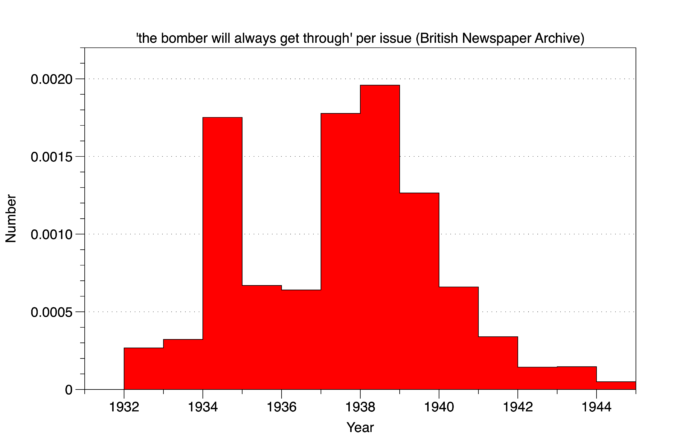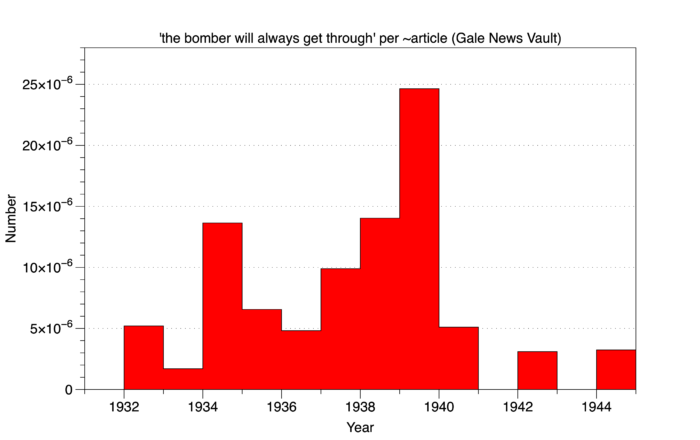
The man: Stanley Baldwin. The place: the House of Commons. The date: 10 November 1932. The quote:
I think it is well also for the man in the street to realize that there is no power on earth that can protect him from being bombed, whatever people may tell him. The bomber will always get through […] The only defence is in offence, which means that you have got to kill more women and children more quickly than the enemy if you want to save yourselves.1
I use this quotation all the time in my scholarly writing: in my book, in four peer-reviewed articles, and in two forthcoming publications (as well as a bunch of times on Airminded). It’s just such a perfect encapsulation of the knock-out blow theory, and from such a prominent British politician too, that I find it impossible to resist. (To be fair, I’m hardly alone.) The only competitor for my affections is by B. H. Liddell Hart:
Imagine for a moment London, Manchester, Birmingham, and half a dozen other great centres simultaneously attacked, the business localities and Fleet Street wrecked, Whitehall a heap of ruins, the slum districts maddened into the impulse to break loose and maraud, the railways cut, factories destroyed. Would not the general will to resist vanish, and what use would be the still determined fraction of the nation, without organization and central direction?2
Which is more vivid, but not as succinct, and doesn’t get across that the consequence of the apparent impossibility of air defence is the logic of mutually assured destruction. And so I always come back to Baldwin. I have used the Liddell Hart quote in my book and in one forthcoming publication, but always as well as ‘the bomber will always get through’, never instead of it. Baldwin is just too quotable.
In attempt to justify this obsession, I’ve had a stab at quantifying just how popular the phrase ‘the bomber will always get through’ was after Baldwin uttered it. The answer, judging from its repetition in the British press, seems to be: not particularly. In 1932, the year of Baldwin’s speech, it appears in the British Newspaper Archive (BNA) just 5 times, and in Gale NewsVault (GNV) only 3 times. (BNA is by far the biggest British newspaper archive, but is overwhelmingly dominated by provincial and local newspapers; GNV, AKA Gale Historical Newspapers, looks to be about a fifth the size, but includes The Times, The Sunday Times, the Evening Express, the Financial Times and the Times Literary Supplement.) True, it became more frequent as the threat of war increased, but so it peaks in BNA in 1938 at just 34 times, and in GNV in 1939 at 13 times. To put that in perspective, ‘bomber’ by itself appears 6031 times in BNA in 1938, and 1731 times in GNV in 1939. So it seems that ‘the bomber will always get through’ didn’t stand in for the bomber fear very often in the way that I often use it. (That doesn’t mean I’m going to stop!)
Still, Baldwin’s speech was sometimes quoted in the British press, so can that tell us anything? Here’s a plot of the frequency of ‘the bomber will always get through’ in BNA between 1931 (i.e. the year before his speech, which should be 0) and 1945, normalised on the total number of newspaper issues in BNA for that year (because BNA has more issues from some years, notably in wartime, than others which would skew the results if uncorrected).

Despite the low absolute numbers this seems to make sense. There’s a peak in 1934, when the World Disarmament Conference was collapsing and Germany was threatening to rearm in the air; an equivalent one in 1938 and 1939, when there was a panic due to the bombing of civilians in Spain and China, and of course the Sudeten crisis; and then the increasingly obvious approach of war with Germany. And a decline thereafter when it became clear that the bomber would not, after all, get through. Still, I’m surprised by the trough in 1935, which I identify as the time of an ‘air panic’.
Here’s the same plot for GNV (this time normalised on the number of articles each year containing the word ‘the’, which is a kludgy way to do it but should be close to the total number of articles):

Again, bearing in mind the small numbers, they’re fairly congruent: peaks in 1934, 1938 and 1939. Relative to 1934 and 1938, however, 1939 is nearly twice the size, while 1937 is nearly as strong. Again, 1935 is not very prominent.
Finally, as a comparison, and because it’s easy to do, how did ‘the bomber get through’ fare in the Australian press? Here is the same plot as above for Trove Newspapers (normalised on the number of articles each year):

This is mostly quite different to the British cases above. The peaks here are 1932 and 1939 (both corresponding to 12 articles), with 1940 not far behind (the Battle of Britain/Blitz, presumably). 1936 and 1938 are also fairly prominent, but there’s a big dip in 1937 (the year of Guernica!) 1935 is again in one of the troughs, but this time so is 1934. Of course, it’s not particularly surprising that the Australian and British presses should differ like this: the aerial threat was felt differently in each nation and at different times. On the other hand, some of the Australian mentions will probably be repeated from the British press (especially in 1932, when Baldwin made his speech), or else appear in discussions of the British situation.
In a future post, I will look a bit more closely at exactly how these newspapers used ‘the bomber will always get through’.
![]() This work is licensed under a Creative Commons Attribution-NonCommercial-NoDerivatives 4.0 International License.
Permissions beyond the scope of this license may be available at http://airminded.org/copyright/.
This work is licensed under a Creative Commons Attribution-NonCommercial-NoDerivatives 4.0 International License.
Permissions beyond the scope of this license may be available at http://airminded.org/copyright/.



